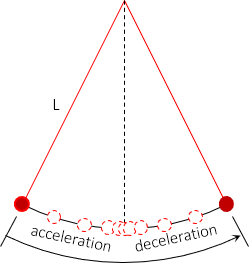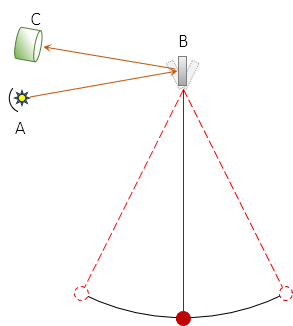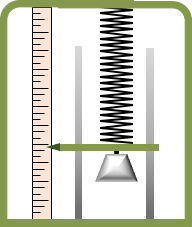3. Early Measuring Devices
a. "England Swings Like a Pendulum Do"1
1 England Swings, composed and sung by Roger Miller, 1965
For about 100 years, beginning c1870, the primary device used to measure gravity was pendulum-based. The first were simple devices with a weight (bob) at the end of a free-swinging rod suspended on a knife-edge fulcrum. The pendulum's period, the time to swing from one side to the other and back again, was affected by gravity - the greater the gravity the shorter the period. Figure E-2 shows the general behavior of a pendulum for half a period, T/2.
 |
| Figure E-2 Simple Pendulum |
Gravity is determined from Equation E-1.
 |
Equation E-1 |
Early pendulums were made of non-magnetic brass, which has a relatively high coefficient of thermal expansion making it very temperature sensitive. Later devices were made of invar with a coefficient less than 10% that of brass. Free swinging in the air affected the pendulum so the rod and bob were encased in vacuum.
Figure E-3 is a typical recording system.
 |
| Figure E-3 Recording |
Light emitted from a source, A, is reflected from a mirror, B, which is attached to and pivots with the pendulum rod. Twice during the pendulum period, when the bob is at its lowest point, the reflected light is directed at a recording device. This continues over a measured time interval. Using the time interval and number of recording hits, T can be determined then substituted in Equation E-1 to compute gravity.
Initially the largest error was time. Before radio broadcasts, time was established in the field by astronomic observations, a lengthy affair. As time determination technology evolved it became a smaller error.
Using a pendulum device, land-based gravity determination was able to reach an accuracy under 10 mgal.
b. Gravimeter
Although around since the late 17th century, gravimeters didn't come into widespread use until the 1950s. Gravimeters are based on the mechanical properties of a spring: a spring expands or contracts in direct proportion to the mass it supports, Equation E-2.
 |
Equation E-2 |
lo: initial spring length
m: mass
g: gravity
k: spring constant
l: final spring length
Figure E-4 is a conceptual schematic of a very basic gravimeter.
 |
| Figure E-4 Gravimeter |
A fixed mass is attached to a spring and allowed to freely hang. Any attached support must allow friction-free vertical movement of the mass. A measuring system is needed to read and record spring length or length change.
There are different spring-based gravimeter designs, from simple devices as in Figure E-4 to more complex versions with weights mounted on pivoting levers. Each design addresses a particular disadvantage or environmental condition. For example, a simple device with an un-dampened system can take a long time to stabilize after being moved. Shipboard gravimeters require a different design and mounting so ship motion has minimal effect on gravity readings.
Depending on the design and implementation, gravimeters were able to achieve accuracy under 6 mgal.